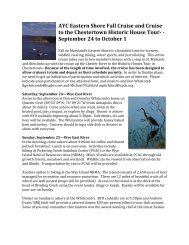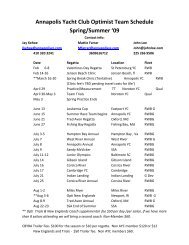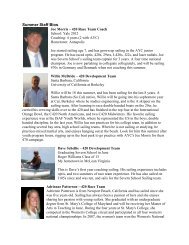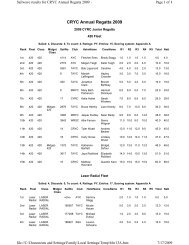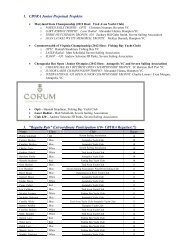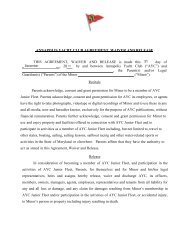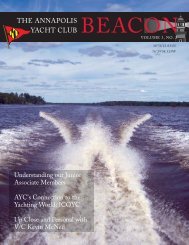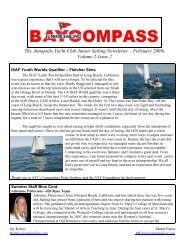You also want an ePaper? Increase the reach of your titles
YUMPU automatically turns print PDFs into web optimized ePapers that Google loves.
Photos from AYC Archives<br />
The <strong>Annapolis</strong> <strong>Yacht</strong> <strong>Club</strong> Story<br />
An Overview<br />
Sanford Morse, <strong>Club</strong> Historian<br />
Part II in a series of two articles<br />
The Growth Years, 1937–1960<br />
The Nation. On the world stage, a trio of dictators had<br />
Europe in turmoil: Franco was done in Spain, at a cost of<br />
one million dead; Mussolini grabbed Albania; and Hitler<br />
had marched into Prague unopposed. The Blitzkrieg<br />
and Poland came next, followed by Denmark, Norway,<br />
Holland, Dunkirk, France, and the London blitz.<br />
America tried not to notice. The World’s Fair in<br />
Flushing Meadows offered a glimpse of the future<br />
1960s: everyone fit and tan after two-month vacations,<br />
driving cars fueled by liquid air, and living in collapsible<br />
houses. Gone with the Wind, the most anticipated event<br />
in Hollywood history, came to the big screen. A teenaged<br />
Mickey Rooney, as Andy Hardy, was the country’s<br />
box office champion.<br />
The City. <strong>Annapolis</strong> was still a small town: barely 10,000<br />
folks, excluding the Naval Academy. The Navy and miles<br />
of shoreline had saved <strong>Annapolis</strong> from the full fury of<br />
the Great Depression. The Academy’s staggering Bancroft<br />
Hall expansion project, for example, provided many<br />
jobs for locals.<br />
By war’s end, <strong>Annapolis</strong> was set for growth. In 1947,<br />
the 1907 bridge across Spa Creek was replaced with<br />
today’s structure. In 1949, the city celebrated its 300th<br />
year. And in 1951, the annexation of West <strong>Annapolis</strong>,<br />
Wardour, Cedar Park, Germantown, Homewood,<br />
Eastport, Tyler Avenue, Forest Hills, Fairfax, Truxton<br />
Heights, and Parole made <strong>Annapolis</strong> the fourth largest<br />
city in Maryland with a population of 25,000. The next<br />
year, 1952, the Chesapeake Bay bridge opened, and ferry<br />
service to the eastern shore ended. In 1957, the John<br />
Hanson Highway was dedicated, which by 1962, as U.S.<br />
50, linked <strong>Annapolis</strong> with Washington, D.C.<br />
The <strong>Annapolis</strong> <strong>Yacht</strong> <strong>Club</strong>. In 1937, the Severn Boat <strong>Club</strong>,<br />
in an effort to rejuvenate its members, reorganized and<br />
incorporated as the <strong>Annapolis</strong> <strong>Yacht</strong> <strong>Club</strong>, and held the<br />
first AYC Annual Regatta Aug. 28 and 29, 1937, open<br />
to “any Corinthian yachtsman.” Around the same time,<br />
January of 1938, a group of <strong>Annapolis</strong> businessmen, all<br />
AYC members, incorporated the <strong>Annapolis</strong> <strong>Yacht</strong> Basin<br />
Company, with the goal of making <strong>Annapolis</strong> the yachting<br />
capital of the inland waterways system.<br />
In 1939, AYC sponsored its first ocean race, from<br />
New London to <strong>Annapolis</strong>, and “all the skippers declared<br />
that it was the best arranged and best conducted<br />
race they had ever sailed.” In October of 1940, the first<br />
Fall Series took place, with five boats competing. Then<br />
World War II interrupted organized racing.<br />
continued on page 8<br />
VOLUME 1, NO. 2<br />
AYC BEACON<br />
7


